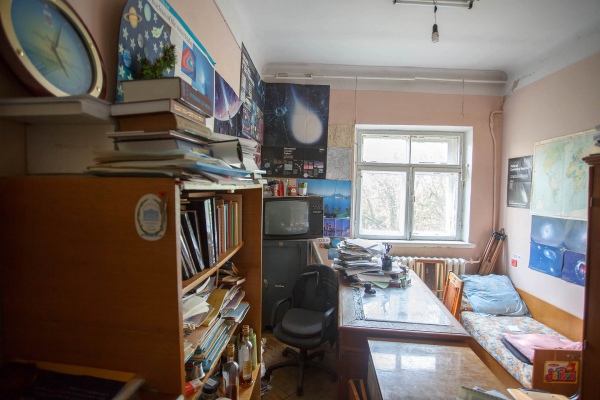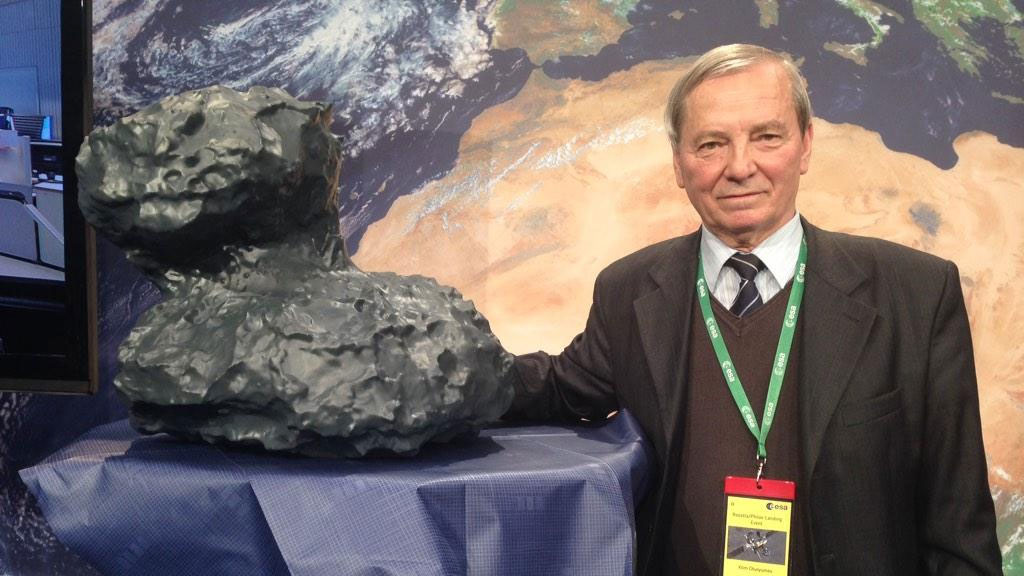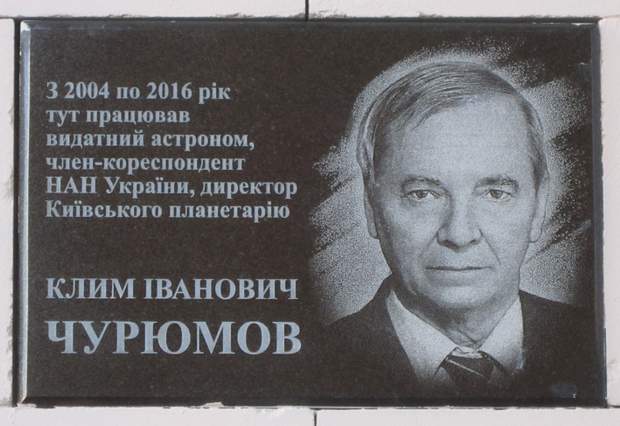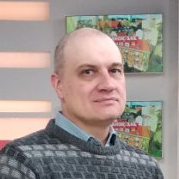On the second floor of the laboratory building of the Astronomical Observatory of Kyiv, there is a small office with a small window facing the observatory park. It is well known to all Ukrainian scientists and astronomy enthusiasts who have been observing comets. The outstanding Ukrainian astronomer Klym Ivanovych Churiumov worked there for almost four decades. He would have turned 87 on February 19…
The walls of the office are decorated with photographs of various comets, posters of international astronomical conferences and numerous diplomas received by the astronomer for his scientific and educational activities. Above the small sofa, where Klym Ivanovych sometimes rested after night observations, there is a world map with marked places that he managed to visit. During Soviet times, when travel abroad was limited, the scientist traveled a lot within the country, including visiting the secret Baikonur and Plesetsk cosmodromes. After 1990, the marks appeared in the USA and Canada, in the UK, Australia, and the Canary Islands… Of all the continents, Africa and Antarctica remained “uncovered”.
When the owner of the office was in place and did not have critical business, he always willingly welcomed guests — especially amateur researchers engaged in observations of comets and asteroids. Many of them came there to find out if a new “tailed star” had accidentally appeared in the sky.
“Comet Circular”
No surprise that a significant part of our readers were born before the advent of the Internet. But it is already difficult for us to imagine the world without it. Now we can find out in a few clicks what interesting celestial events are expected in the coming days. Previously, the main source of information about them was a variety of “astronomical calendars”, but only regarding objects and phenomena that had already been discovered and that could be foreseen. The discovery of comets is unexpected in most cases, and without a quick reliable way to report them, the next “tailed star” could well have been missed.

To fill this “information gap”, in 1963, the director of the observatory, Serhii Vsekhsviatskyi, initiated the release of the “Comet Circular”, which contained information about recently discovered comets, the results of observations already known, as well as important symposiums and conferences of scientists engaged in the study of these unusual celestial bodies. After Vsekhsviatskyi’s death, Klym Ivanovych assumed this responsibility. It happened that the circular was printed on an ordinary typewriter, and then reproduced on a large rotary copier. Then it was manually packed into envelopes and sent to subscribers — mostly from the USSR, but there were foreign observatories among them. Many astronomy enthusiasts had been looking forward to this unique edition. But the spread of the world wide web and e-mail has made it obsolete. The last issues of the circular were published in 1999.
“Club of two-comet astronomers”
Klym Ivanovych often said that he was lucky with the first comet: “one was photographed, but another got on the photographic plate.” In his opinion, any astronomer who regularly observed the starry sky could have accidentally discovered the comet. But such a discovery did not yet give him the right to be called a “cometer” — for this he needed to open at least one more. Such a comet was discovered on July 14, 1986, during an expedition to the Coronal Station of the Astrophysical Institute of the Academy of Sciences of the Kazakh SSR near Almaty. This time, the co-author of the discovery was Valentyn Solodovnykov, respectively, this comet was named Churiumov-Solodovnykov. According to modern nomenclature, it has the designation C/1986 N1. The period of its orbit around the Sun is about 12 thousand years.

In fact, not many Soviet astronomers were twice “noted” in the name of the comet. One of them was Mykola Chernykh, an employee of the Crimean Astrophysical Observatory. He was also actively engaged in the search for asteroids and discovered 537 of them in total (and the group he led — more than 1200). Among the new objects discovered by him in 1984 was the “heavenly stone”, which later received the number 2627 and the name “Churiumov” proposed by the discoverer.
Comet of a Lifetime
But the Kyiv astronomer became famous most of all thanks to his first discovery — comet Churiumov–Herasymenko (67P/Churiumov–Herasymenko). Of course, he was incredibly lucky with it — also in the fact that it turned out to be short-period, returning to the Sun about every six and a half years… but what a darling of fate you need to be to send a specialized spacecraft to the comet you discovered!
The Rosetta probe was launched by the European Space Agency from the Kourou cosmodrome (French Guiana) on March 2, 2004. Klym Churiumov and Svitlana Gerasimenko were present at the launch. The spacecraft arrived at its target in 2014, after which it studied the cometary core from a close distance for two years. Unfortunately, the Philae module dropped on it could not fully fulfill its scientific program, but this project is considered one of the most successful interplanetary missions. Scientists will decode its results for many more years.

In the last years of his life, Klym Ivanovych took an active part in events, TV shows and scientific programs related to the Rosetta mission. As a specialist, he commented on its progress and the data obtained. Finally, according to the decision of the ESA, the spacecraft was sent to the comet’s core and collided with it on September 30, 2016, after which it stopped working.
And two weeks later, on the night of October 14-15, Klym Ivanovych Churiumov died on the Kyiv-Kharkiv train at the age of 79. In this mystical way, his life turned out to be connected with his comet.
In December 2022, the Kyiv City Council decided to rename Yasnopolianska Street in the Sviatoshynskyi district in honor of Klym Churiumov. So the name of the scientist appeared on the map of the city where most of his life was spent.
By the way, Klym Ivanovych was born on the same day as the famous Nicolaus Copernicus — only 464 years later…
Follow us on Twitter to get the most interesting space news in time
https://twitter.comne/ust_magazine


